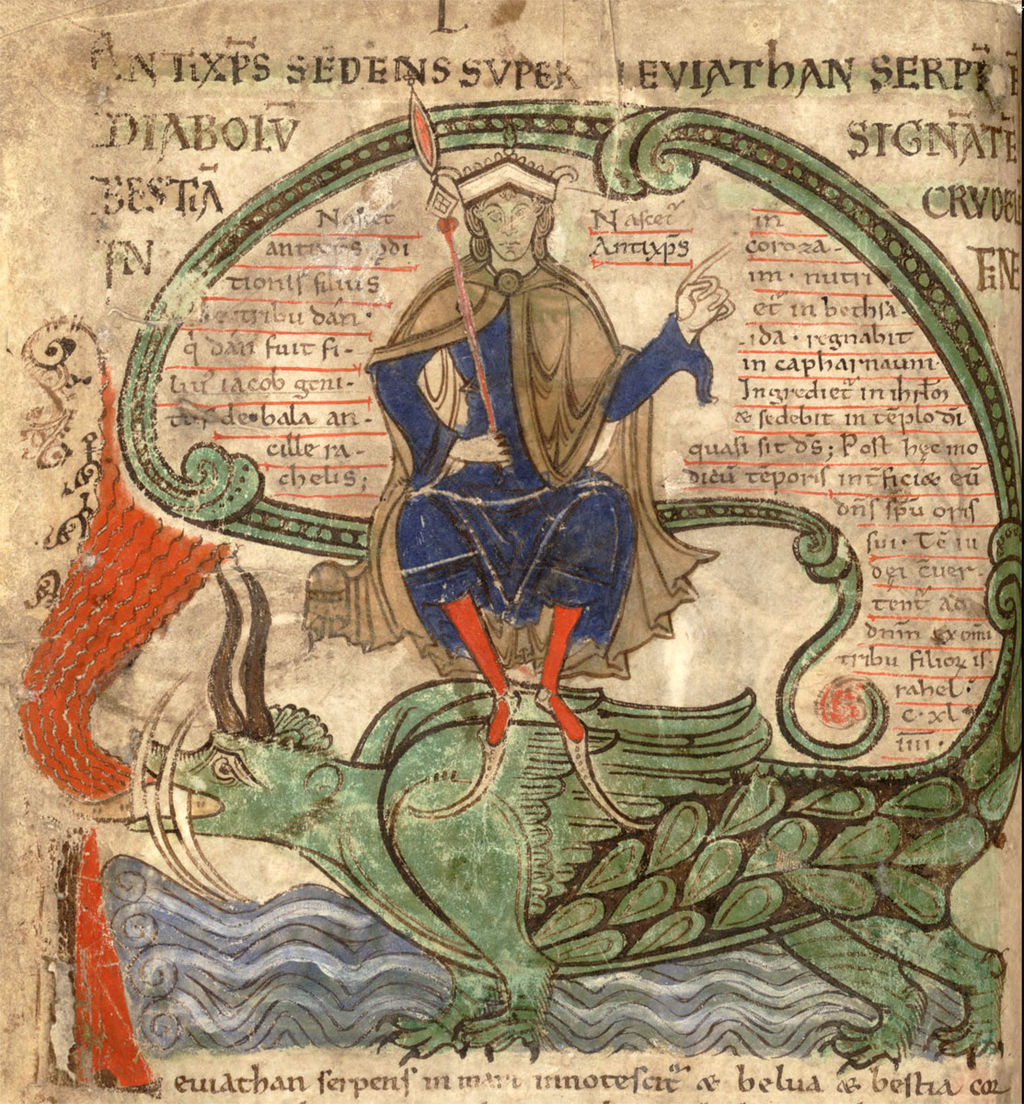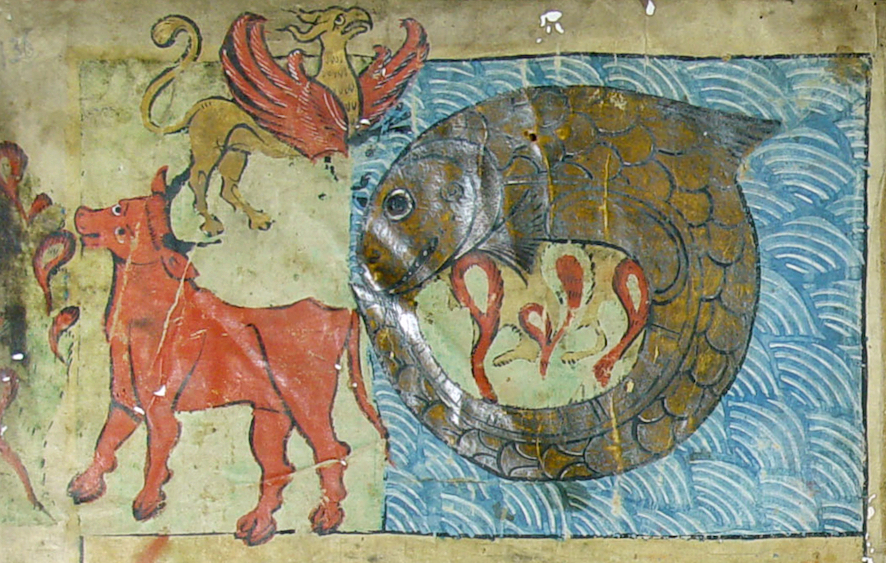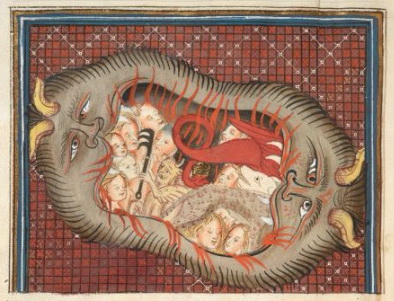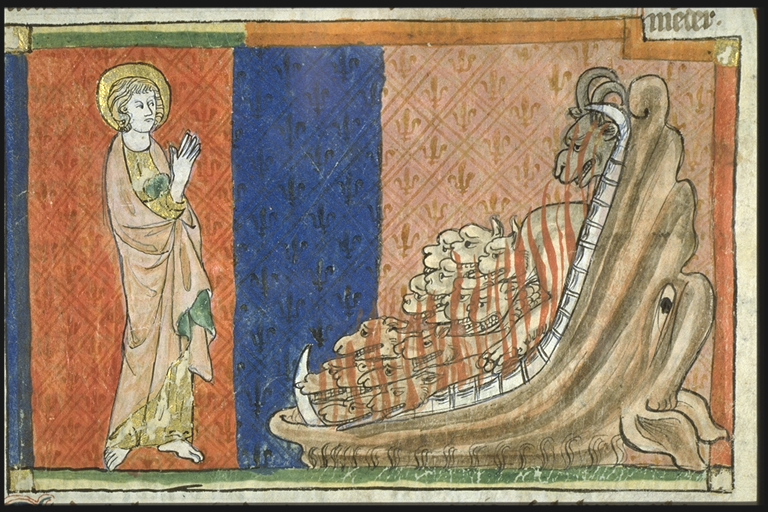
海龍リヴァイアサン
Leviathan

Antichrist on Leviathan, Liber
floridus, 1120
★リ ヴァイアサン (/lɪˈ; Hebrew: לִוֵתֵ) は神学と神話の中で言及されている海の蛇である。1651年のトーマス・ホッブスの 著作『リヴァイアサン』 の名前の由来は、ホッブズの著作のタイトルは、『ヨブ記』に登場するリヴァイアサンを暗示している。ロックやホッブズの『法の要素』など、近世の政治哲学 の著作につけられ た、単に情報を提供するタイトルとは対照的に、ホッブズはこの挑発的な論考に、より詩的な名前を選んだと言われている。
| Leviathan
(/lɪˈvaɪ.əθən/; Hebrew: לִוְיָתָן, Līvyāṯān) is a sea serpent noted in
theology and mythology. It is referenced in several books of the Hebrew
Bible, including Psalms, the Book of Job, the Book of Isaiah, the Book
of Amos, and, according to some translations, in the Book of
Jonah;[citation needed] it is also mentioned in the Book of Enoch. The
Leviathan is often an embodiment of chaos and threatening to eat the
damned after their life. In the end, it is annihilated. Christian
theologians identified Leviathan with the demon of the deadly sin envy.
According to Ophite diagrams, the Leviathan encapsulates the space of
the material world. The Leviathan of the Book of Job is a reflection of the older Canaanite Lotan, a primeval monster defeated by the god Baal Hadad. Parallels to the role of Mesopotamian Tiamat defeated by Marduk have long been drawn in comparative mythology, as have been wider comparisons to dragon and world serpent narratives such as Indra slaying Vrtra or Thor slaying Jörmungandr.[1] Leviathan also figures in the Hebrew Bible as a metaphor for a powerful enemy, notably Babylon (Isaiah 27:1). Some 19th-century scholars pragmatically interpreted it as referring to large aquatic creatures, such as the crocodile.[2] The word later came to be used as a term for great whale, and for sea monsters in general. |
リ
ヴァイアサン (/lɪˈ; Hebrew: לִוֵתֵ)
は神学と神話の中で言及されている海の蛇である。ヘブライ語聖書の詩篇、ヨブ記、イザヤ書、アモス書、そして翻訳によってはヨナ書にも言及されている
[citation
needed]。リヴァイアサンはしばしば混沌の具現化であり、生を終えた呪われた者を食べると脅す。最後には消滅させられる。キリスト教の神学者たち
は、リヴァイアサンを大罪である嫉妬の悪魔と同定した。オフィットの図によると、リヴァイアサンは物質世界の空間を封じ込めたものである。 ヨブ記のリヴァイアサンは、バールハダド神によって倒された原始の怪物であるカナン人のロタンに由来するものである。メソポタミアのティアマトがマル ドゥークに倒されたのと類似しており、インドラがヴルトラ、トールがヨルムンガンドを倒すといった竜や大蛇の物語と比較されることが多い[1]...。 19世紀の学者の中には、この言葉をワニのような大型の水生生物を指すと実用的に解釈する者もいた[2]。 この言葉は後に、大鯨や海の怪物一般を指す言葉として使われるようになった。 |
| Etymology and origins Gesenius (among others) argued the name לִוְיָתָן was derived from the root לוה lwh "to twine; to join", with an adjectival suffix ן-, for a literal meaning of "wreathed, twisted in folds".[2] If it exists, the adjectival suffix ן- (as opposed to -ון) is otherwise unattested except perhaps in Nehushtan, whose etymology is unknown; the ת would also require explanation, as Nechushtan is formed from neḥšoeṯ and Leviathan from liveyah; the normal-pattern f.s. adjective would be לויון, liveyon. Other philologists, including Leskien, thought it a foreign loanword.[3] A third school considers it a proper noun.[4] Bauer proposed לוית+תן, for "wreath of serpent."[5] Both the name and the mythological figure are a direct continuation of the Ugaritic sea monster Lôtān, one of the servants of the sea god Yammu defeated by Hadad in the Baal Cycle.[6][7] The Ugaritic account has gaps, making it unclear whether some phrases describe him or other monsters at Yammu's disposal such as Tunannu (the biblical Tannin).[8] Most scholars agree on describing Lôtān as "the fugitive serpent" (bṯn brḥ)[7] but he may or may not be "the wriggling serpent" (bṯn ʿqltn) or "the mighty one with seven heads" (šlyṭ d.šbʿt rašm).[9] His role seems to have been prefigured by the earlier serpent Têmtum whose death at the hands of Hadad is depicted in Syrian seals of the 18th–16th century BC.[9] Sea serpents feature prominently in the mythology of the ancient Near East.[10] They are attested by the 3rd millennium BC in Sumerian iconography depicting the god Ninurta overcoming a seven-headed serpent. It was common for Near Eastern religions to include a Chaoskampf: a cosmic battle between a sea monster representing the forces of chaos and a creator god or culture hero who imposes order by force.[11] The Babylonian creation myth describes Marduk's defeat of the serpent goddess Tiamat, whose body was used to create the heavens and the earth.[12] |
語源と由来 ゲセニウスは、「לִוְיָתָן」は「絡める、繋ぐ」の語源で、「ひだのある、ねじれた」という意味の形容詞的接尾辞ן-に由来すると主張した [2]。 [2]もし存在するとすれば,(-וןに対して)形容詞的接尾辞ן-は,おそらく語源不明のNehushtanを除いては前例がない; Nechushtanはneḥšoeṯ,Leviathanはliveyahから形成されているので,תについても説明を要する;通常のパターンのf. s. 形容詞は לויון, liveyon となる。レスキュンを含む他の言語学者はこれを外国語の借用語と考えた[3]。 第三派はこれを固有名詞と考える[4]。バウアーは「蛇の花輪」を表すלוית+תןを提案した[5]。 この名前と神話の人物は、バアル・サイクルでハダドに倒された海神ヤムーのしもべであるウガリット語の海の怪物ロターンをそのまま引き継いでいる[6] [7]。 ウガリット語の記述には隙間があり、あるフレーズが彼を表すのかヤムーの手下のトゥナヌ(聖書のタニン)のような他の怪物を表すのかは不明である[8]。 [8] ほとんどの学者はロターンを「逃亡する大蛇」(bṯ brḥ)と表現することで一致しているが[7]、「蠢く大蛇」(bṯ qltn)や「7つの頭を持つ強大者」(šlyṭ d.)であるかも知れないしそうでないかも知れない。 šb+t rašm)。彼の役割は、紀元前18世紀から16世紀のシリアの印章に描かれている、ハダドの手によって死んだ以前の大蛇テムタムによって予表されていた ようである[9]。 海蛇は古代近東の神話に顕著に登場する[10]。紀元前3千年紀にはシュメール語の図像に、ニヌルタ神が7つの頭を持つ蛇を克服した様子が描かれている。 近東の宗教では、混沌の力を表す海の怪物と、力によって秩序を与える創造神や文化の英雄との間の宇宙規模の戦いであるカオスカンフーを含むのが一般的だっ た[11]。バビロニアの創造神話では、マルドゥクが蛇の女神ティアマトを倒し、その体を用いて天と地を創造したことが描写されている[12]。 |
| Tanakh The Leviathan specifically is mentioned six times in the Tanakh, in Job 3:8, Job 40:15–41:26, Psalm 74:14, Psalm 104:26 and twice in Isaiah 27:1. Job 41:1–34 is dedicated to describing him in detail: "Behold, the hope of him is in vain; shall not one be cast down even at the sight of him?"[13] Included in God's lengthy description of his indomitable creation is Leviathan's fire-breathing ability, his impenetrable scales, and his overall indomitability in Job 41.In Psalm 104, God is praised for having made all things, including Leviathan, and in Isaiah 27:1, he is called the "tortuous serpent" who will be killed at the end of time.[10] The mention of the Tannins in the Genesis creation narrative[14] (translated as "great whales" in the King James Version),[15] in Job, and in the Psalm[16] do not describe them as harmful but as ocean creatures who are part of God's creation. The element of competition between God and the sea monster and the use of Leviathan to describe the powerful enemies of Israel[17] may reflect the influence of the Mesopotamian and Canaanite legends or the contest in Egyptian mythology between the Apep snake and the sun god Ra. Alternatively, the removal of such competition may have reflected an attempt to naturalize Leviathan in a process that demoted it from deity to demon to monster.[18][19][page needed] |
タナック ヨブ記3:8、ヨブ記40:15-41:26、詩編74:14、詩編104:26、イザヤ書27:1の6回で、レビヤタンが具体的に言及されている。 ヨブ記41:1-34は彼のことを詳しく描写しています。「詩篇104編では、神がレビヤタンを含む万物を創造したことを賞賛し、イザヤ書27章1節で は、時の終わりに殺される「ねじれた蛇」と呼ばれている[10]。 創世記の創造物語[14](欽定訳では「大クジラ」と訳されている)、ヨブ記、詩編[16]におけるタンニンの言及は、有害なものとしてではなく、神の創 造の一部である海洋生物として描写している。神と海の怪物の競争という要素や、イスラエルの強敵を表すのにリヴァイアサンが使われるのは[17]、メソポ タミアやカナン人の伝説の影響か、エジプト神話におけるアペップの蛇と太陽神ラーの争いを反映しているのかもしれない。あるいは、そうした競争を排除した のは、リヴァイアサンを神から悪魔、怪物へと降格させる過程で自然化しようとしたことを反映しているかもしれない[18][19][要ページ]。 |
| Judaism Later Jewish sources describe Leviathan as a dragon who lives over the sources of the Deep and who, along with the male land-monster Behemoth, will be served up to the righteous at the end of time. The Book of Enoch (60:7–9) describes Leviathan as a female monster dwelling in the watery abyss (as Tiamat), while Behemoth is a male monster living in the desert of Dunaydin ("east of Eden").[10] When the Jewish midrash (explanations of the Tanakh) were being composed, it was held that God originally produced a male and a female leviathan, but lest in multiplying the species should destroy the world, he slew the female, reserving her flesh for the banquet that will be given to the righteous on the advent of the Messiah.[20][21] A similar description appears in Book of Enoch (60:24), which describes how the Behemoth and Leviathan will be prepared as part of an eschatological meal. Rashi's commentary on Genesis 1:21 repeats the tradition: the...sea monsters: The great fish in the sea, and in the words of the Aggadah (B.B. 74b), this refers to the Leviathan and its mate, for He created them male and female, and He slew the female and salted her away for the righteous in the future, for if they would propagate, the world could not exist because of them. הַתַּנִינִם is written. [I.e., the final "yud", which denotes the plural, is missing, hence the implication that the Leviathan did not remain two, but that its number was reduced to one.] – [from Gen. Rabbah 7:4, Midrash Chaseroth V’Yetheroth, Batei Midrashoth, vol 2, p. 225].[22] In the Talmud Baba Bathra 75 it is told that the Leviathan will be slain and its flesh served as a feast to the righteous in [the] Time to Come and its skin used to cover the tent where the banquet will take place. Those who do not deserve to consume its flesh beneath the tent may receive various vestments of the Leviathan varying from coverings (for the somewhat deserving) to amulets (for the least deserving). The remaining skin of the Leviathan will be spread onto the walls of Jerusalem, thereby illuminating the world with its brightness. The festival of Sukkot (Festival of Booths) therefore concludes with a prayer recited upon leaving the sukkah (booth): "May it be your will, Lord our God and God of our forefathers, that just as I have fulfilled and dwelt in this sukkah, so may I merit in the coming year to dwell in the sukkah of the skin of Leviathan. Next year in Jerusalem."[23] The enormous size of the Leviathan is described by Johanan bar Nappaha, from whom proceeded nearly all the aggadot concerning this monster: "Once we went in a ship and saw a fish which put his head out of the water. He had horns upon which was written: 'I am one of the meanest creatures that inhabit the sea. I am three hundred miles in length, and enter this day into the jaws of the Leviathan'".[24][21] When the Leviathan is hungry, reports Rabbi Dimi in the name of Rabbi Johanan, he sends forth from his mouth a heat so great as to make all the waters of the deep boil, and if he would put his head into Paradise no living creature could endure the odor of him.[24] His abode is the Mediterranean Sea; and the waters of the Jordan fall into his mouth.[25][21] In a legend recorded in the Midrash called Pirke de-Rabbi Eliezer it is stated that the fish which swallowed Jonah narrowly avoided being eaten by the Leviathan, which eats one whale each day.[26] The body of the Leviathan, especially his eyes, possesses great illuminating power. This was the opinion of Rabbi Eliezer, who, in the course of a voyage in company with Rabbi Joshua, explained to the latter, when frightened by the sudden appearance of a brilliant light, that it probably proceeded from the eyes of the Leviathan. He referred his companion to the words of Job 41:18: "By his neesings a light doth shine, and his eyes are like the eyelids of the morning".[27] However, in spite of his supernatural strength, the leviathan is afraid of a small worm called "kilbit", which clings to the gills of large fish and kills them.[28][21] In the eleventh-century piyyut (religious poem), Akdamut, recited on Shavuot (Pentecost), it is envisioned that, ultimately, God will slaughter the Leviathan, which is described as having "mighty fins" (and, therefore, a kosher fish, not an inedible snake or crocodile), and it will be served as a sumptuous banquet for all the righteous in Heaven. In the Zohar, the Leviathan is a metaphor for enlightenment. The Zohar remarks that the legend of the righteous eating the skin of the leviathan at the end of the days is not literal, and merely a metaphor for enlightenment.[29] The Zohar also specifies in detail that the Leviathan has a mate.[30] The Zohar also associates the metaphor of the leviathan with the "tzaddik" or righteous in Zohar 2:11b and 3:58a. The Zohar associates it with the "briach" the pole in the middle of the boards of the tabernacle in Zohar 2:20a. Both, are associated with the Sefira of Yesod.[31] According to Abraham Isaac Kook, the Leviathan – a singular creature with no mate, "its tail is placed in its mouth" (Zohar) "twisting around and encompassing the entire world" (Rashi on Baba Batra 74b) – projects a vivid metaphor for the universe's underlying unity. This unity will only be revealed in the future, when the righteous will feast on the Leviathan.[32] |
ユダヤ教 後のユダヤ教資料によると、レヴィアタンは深淵の源に住む竜で、雄の陸の怪物ベヒモスと共に、時の終わりに正しい者に仕えることになると記述されている。 エノク書』(60:7-9)では、リヴァイアサンは(ティアマトとして)水の深淵に住む女の怪物であり、ベヒモスは(「エデンの東」)デュネイディンの砂 漠に住む男の怪物であると記述されている[10]。 ユダヤ教のミドラーシュ(タナフの解説)が作成されたとき、神はもともと雄と雌のレヴィアタンを生み出したが、種を増やすことで世界を滅ぼさないように、 雌を殺して、その肉をメシアの到来時に正しい者たちに与えられる宴会のために取っておいたとされた。 エノク書(60:24)に同様の記述があり、終末の食事の一部として、ベヒモスとレヴィアタンがどのように調理されるかが記述されている[20] [21]。 創世記1:21に対するラシの注釈でも、この伝統が繰り返されている。 海の怪物たち。Aggadah (B.B. 74b)の言葉を借りれば、これはリヴァイアサンとその仲間を指している。神は彼らを雄と雌に創造し、雌を殺して将来の正しい者のために塩漬けにした。 הַתּנִינִםが書かれています。[つまり、複数形を示す最後の "yud "が欠落しているので、リヴァイアサンは二人のままではなく、その数が一人に減らされたことを暗示している]。- 創世記ラバ7:4、『ミドラーシュ・シャセロット・ヴェテロス』バテイ・ミドラーシュ、第2巻、225頁より][22][22]. タルムード『ババ・バトラ』75章には、リヴァイアサンは殺され、その肉は[来るべき時]に正しい者たちの宴会として供され、その皮は宴会が行われる天幕 を覆うために使われると記されている。天幕の下でその肉を食べるに値しない者は、リヴァイアサンの様々な衣を受け取ることができる。衣の種類は、(ある程 度価値のある)カバーから(最も価値のない)お守りまで様々である。リヴァイアサンの残りの皮はエルサレムの城壁に敷き詰められ、その輝きで世界を照ら す。そのため、スッコトの祭りは、スッカ(小屋)から出るときに唱える祈りで締めくくられる。「私たちの神、主よ、私たちの先祖の神、あなたの御心であり ますように、私がこのスッカを満たして住んだように、来年はリヴァイアサンの皮のスッカに住めるように功徳がありますように。来年はエルサレムで」 [23]。 リヴァイアサンの巨大さについては、ヨハナン・バル・ナッパハが記述している。彼は、この怪物に関するほとんどすべてのアガドトをこの人物から引き出して いる。「あるとき、私たちは船に乗って、水面から頭を出した魚を見た。その魚には角があり、その角にはこう書かれていた。私は海に棲む最も卑しい生き物の 一人である。私は体長300マイルで、今日、リヴァイアサンのあごに入る』」と書かれていた[24][21]。 ラビ・ヨハナンの名でラビ・ディミが報告しているところによれば、リヴァイアサンは空腹になると、その口から深海のすべての水を沸騰させるほどの熱を発 し、もし彼が楽園に頭を入れようとしても、生き物は彼の臭いに耐えられない[24]。 彼の住まいは地中海で、ヨルダン川の水は彼の口に落ちるという[25][21]。 ピルケ・デ・ラビ・エリエゼルと呼ばれるミドラッシュで記録された伝説では、ヨナを飲み込んだ魚は、毎日1頭の鯨を食べるリヴァイアサンに食べられるのを 辛うじて免れたと述べられている[26]。 リヴァイアサンの体、特にその目には、大きな光力がある。これはラビ・エリエゼルの意見である。彼はラビ・ヨシュアと一緒に航海している途中、突然現れた 輝く光に怯えたヨシュアに、それはおそらくリヴァイアサンの目から出たものであろうと説明した。彼はヨブ記41:18の言葉を仲間に紹介した:「彼の鼻に よって光が輝き、その目は朝のまぶたのようだ」[27]。 しかし、その超自然的な力にもかかわらず、リヴァイアサンは「キリビット」という小さな虫を恐れ、大きな魚のエラに付着してそれを殺してしまうのである [28][21]。 11世紀のピユート(宗教詩)『アクダムート』では、シャブオット(聖霊降臨祭)に唱えられるが、最終的に神がリヴァイアサンを屠ることが想定されてお り、リヴァイアサンは「強大なヒレ」を持っていると描写されており(したがって、食べられない蛇やワニではなくコーシャ魚)、それは天国ですべての正しい 人々のための豪華な晩餐会として振る舞われるとされている[21]。 ゾハルでは、リヴァイアサンは悟りのメタファーである。ゾハルは、正しい者が日の終わりにリヴァイアサンの皮を食べるという伝説は文字通りのものではな く、単に悟りのメタファーであると述べている[29]。ゾハルはまた、リヴァイアサンには仲間がいると詳細に特定している[30]。ゾハル2:11bと 3:58aではリヴァイアサスのメタファーを「tzaddik」つまり正しい者と関連付けてもいる。ゾハル2:20aでは、幕屋の板の中央にある「ブリ アッハ」という棒と関連付けている。どちらもイェソドのセフィラに関連している[31]。 アブラハム・アイザック・クックによれば、リヴァイアサンは、仲間を持たず、「尾が口の中に入っている」(ゾハル)「ねじれて世界全体を包む」(ババ・バ トラ74bのラシ)特異な生物で、宇宙の根本的な統一を鮮明に隠喩している。この統一性は、将来、正しい者がリヴァイアサンを食らうときにのみ明らかにさ れる[32]。 |
 |
Leviathan the sea-monster, with Behemoth the land-monster and Ziz the air-monster. "And on that day were two monsters parted, a female monster named Leviathan, to dwell in the abysses of the ocean over the fountains of the waters. But the male is named Behemoth, who occupied with his breast a waste wilderness named Duidain." (1 Enoch 60:7–8) |
 |
"Leviathan" (1983) a painting by Michael Sgan-Cohen, the Israel Museum Collection, Jerusalem |
| Christianity Leviathan can also be used as an image of the devil, endangering both God's creatures—by attempting to eat them—and God's creation—by threatening it with upheaval in the waters of Chaos.[33] A "Dragon" (Drakon), being the usual translation for the Leviathan in the Septuaginta, appears in the Book of Revelation. Although the Old Testament nowhere identifies the Leviathan with the devil, the seven-headed dragon in the Book of Revelation is.[34] By this the battle between God and the primordial chaos monsters shifts to a battle between God and the devil.[35] Only once, in the Book of Job, the Leviathan is translated as Sea-Monster (ketos).[35] In the following chapter, a seven-headed beast, described with the same features as the dragon before, rises from the waters endowing a Beast of the Earth with power. Dividing the beasts into monster of water and one of dry earth is probably a recalling of the monstrous pair Leviathan and Behemoth.[36] In accordance with Isaiah 27:1, the dragon will be slain by God on the last day and cast into the abyss.[35][36] The annihilation of the chaos-monster results in a new world of peace, without any trace of evil.[35] Jerome comments on Psalm 104:26 that "this is the dragon that was cast out of Paradise, that beguiled Eve, and is permitted in this world to make sport of us. How many monks and clerics has it dashed headlong! “They all look to you to give them food in due time,” for all the creatures of God live at His bidding."[37] St. Thomas Aquinas described Leviathan as the demon of envy, first in punishing the corresponding sinners (Expositio super Iob ad litteram). Peter Binsfeld likewise classified Leviathan as the demon of envy, as one of the seven Princes of Hell corresponding to the seven deadly sins. Leviathan became associated with, and may originally have been referred to by, the visual motif of the Hellmouth, a monstrous animal into whose mouth the damned disappear at the Last Judgement, found in Anglo-Saxon art from about 800, and later all over Europe.[38][39] The Revised Standard Version of the Bible suggests in a footnote to Job 41:1 that Leviathan may be a name for the crocodile, and in a footnote to Job 40:15, that Behemoth may be a name for the hippopotamus.[40] |
キリスト教世界 リヴァイアサンは悪魔のイメージとしても使われ、神の被造物を食べようとし、神の創造物を脅かし、カオスの水の中で動揺させる。セプトゥアギンタではリ ヴァイアサンの通常の翻訳である「龍」(ドラコン)が黙示録に登場する[33]。旧約聖書ではリヴァイアサンを悪魔とする記述はないが、黙示録の七つの頭 を持つ竜は悪魔である[34]。これによって、神と原初のカオスの怪物の戦いは、神と悪魔の戦いに移行する[35]。一度のみ、ヨブ記でリヴァイアサン は海獣(ケトス)と訳されている[35]。 次の章では、以前のドラゴンと同じ特徴を持つ7つの頭を持つ獣が、水の中から上昇し、地の獣に力を与える描写がある。獣を水の怪物と乾いた地の怪物に分け たのは、おそらくレヴィアタンとベヒモスの怪物コンビを想起させる[36]。イザヤ書27:1に従って、龍は終わりの日に神によって殺され、奈落の底に落 とされる。カオスモンスターの消滅によって、悪の痕跡のない平和な新世界が到来する[35][36]。 ジェロームは詩篇104:26について、「これは楽園から追い出され、イブを惑わした竜であり、この世で私たちをからかうことを許されている」とコメント している[35]。この竜は、どれほど多くの修道士や聖職者を真っ逆さまに打ち落としたことでしょう。「神のすべての被造物は、神の命令によって生きてい るのだから」[37] 「彼らはみな、やがて食べ物を与えてくれるよう、あなたに期待している。 聖トマス・アクィナスはリヴァイアサンを嫉妬の悪魔と表現し、まず対応する罪人を罰する (Expositio super Iob ad litteram) とした。ピーター・ビンスフェルドも同様に、七つの大罪に対応する地獄の七人の王子の一人として、リヴァイアサンを嫉妬の悪魔として分類している。リヴァ イアサンは、800年頃からのアングロサクソン美術に見られる、最後の審判で地獄に堕ちた者がその口に入る怪獣という視覚的モチーフと関連し、元々それを 指していたかもしれない[38][39]。 Revised Standard Version of the BibleはJob 41:1への脚注でLeviathanがワニの名前である可能性を示唆し、Job 40:15への脚注でBehemothがカバの名前である可能性を示唆している[40]。 |
 |
Hellmouth The life of St John
and Apocalypse, circa 1400 |
 |
Saint John sees the devil,
vanquished forever, cast into hell with the Beast and False Prophet |
| Satanism Anton LaVey in The Satanic Bible (1969) has Leviathan representing the element of Water and the direction of west, listing it as one of the Four Crown Princes of Hell. This association was inspired by the demonic hierarchy from The Book of the Sacred Magic of Abra-Melin the Mage. The Church of Satan uses the Hebrew letters at each of the points of the Sigil of Baphomet to represent Leviathan. Starting from the lowest point of the pentagram, and reading counter-clockwise, the word reads "לויתן": (Nun, Tav, Yod, Vav, Lamed) Hebrew for "Leviathan".[41] |
悪魔崇拝 アントン・ラヴェイは『悪魔の聖書』(1969年)の中で、リヴァイアサンは水の元素と西の方角を表し、地獄の四天王の一人に挙げられています。この関連 付けは、『魔道士アブラメリンの聖なる魔法の書』の悪魔の階層に触発されたものである。悪魔教会では、バフォメットの紋章の各点にあるヘブライ文字を使っ て、リヴァイアサンを表現している。五芒星の最下点から始めて反時計回りに読むと、「לויתן」:(ヌン、タヴ、ヨド、ヴァヴ、ラメッド)ヘブライ語で 「リヴァイアサン」を意味する[41]。 |
| Gnosticism The Church Father Origen accused a Gnostic sect of venerating the biblical serpent of the Garden of Eden. Therefore, he calls them Ophites, naming after the serpent they are supposed to worship.[42] In this belief system, the Leviathan appears as an Ouroboros, separating the divine realm from humanity by enveloping or permeating the material world.[43][42][44] It is unknown whether or not the Ophites actually identified the serpent of the Garden of Eden with the Leviathan.[42] However, since the Leviathan is basically connoted negatively in this Gnostic cosmology, if they identified him with the serpent of the Book of Genesis, he was probably indeed considered evil and just its advice was good.[45] According to the cosmology of this Gnostic sect, the world is encapsulated by the Leviathan, in form of a dragon-shaped archon, biting its own tail (ouroboros). Generating the intrinsic evil in the entire universe, the Leviathan separates the lower world, governed by the Archons, from the realm of God.[46] After death, a soul must pass through the seven spheres of the heavens. If the soul does not succeed, it will be swallowed by the Leviathan, who holds the world captive and returns the soul into an animal body.[47] In Mandaeism, Leviathan is regarded as being coessential with a demon called Ur.[48] In Manichaeism, an ancient religion influenced by Gnostic ideas, the Leviathan is killed by the sons of the fallen angel Shemyaza. This act is not portrayed as heroic, but as foolish, symbolizing the greatest triumphs as transient, since both are killed by archangels in turn after boasting about their victory. This reflects Manichaean criticism on royal power and advocates asceticism.[49] |
グノーシス主義 教父オリゲンは、グノーシス主義の一派が聖書にあるエデンの園の蛇を崇拝していると非難した。そのため、彼は彼らをオフィテスと呼び、彼らが崇拝するとさ れる蛇にちなんで命名した[42]。この信仰体系では、リヴァイアサンはウロボロスとして現れ、物質界を包み込むか浸透することによって人間から神の領域 を切り離すとされている。 [43][42][44] オフィトの人々が実際にエデンの園の蛇をリヴァイアサンと同一視したかどうかは不明である[42]。 しかし、このグノーシスの宇宙論ではリヴァイアサンは基本的に否定的に意味づけられているので、もし彼らが彼を創世記の蛇と同一視していたとすれば、彼は 確かに悪とみなされ、ただその助言は善であったのかも知れない[45]。 このグノーシス派の宇宙論によれば、世界は竜の形をしたアーコンの形をしたリヴァイアサンによって封じ込められ、自らの尾を噛んでいる(ウロボロス)。全 宇宙に内在する悪を生み出すリヴァイアサンは、アルコンに支配された下層世界を神の領域から分離する[46]。死後、魂は天界の7つの球を通過しなければ ならない。もし魂が成功しなければ、世界を捕らえているリヴァイアサンに飲み込まれ、魂は動物の身体に戻される[47]。 マンデ教の場合、リヴァイアサンはウルと呼ばれる悪魔と同体であるとされる[48]。 グノーシス主義の思想に影響された古代宗教であるマニ教では、リヴァイアサンは堕天使シェミャザの息子たちによって殺される。この行為は英雄的なものでは なく、愚かなものとして描かれており、勝利を誇った後に両者が順番に大天使によって殺されることから、最大の勝利が儚いものであることを象徴している。こ れは王権に対するマニ教的批判を反映し、禁欲主義を提唱している[49]。 |
| Secularity The word Leviathan has come to refer to any sea monster, and from the early 17th century has also been used to refer to overwhelmingly powerful people or things (comparable to Behemoth, also a biblical term), influentially so by Hobbes' book (1651).[citation needed] As a term for sea monster, it has also been used of great whales in particular, e.g. in Herman Melville's Moby-Dick - Although in the first Hebrew translation of the novel, translator Elyahu Burtinker chose to translate "Whale" to "Tanin" (intending to refer to another sea monster although in Modern Hebrew usage Tanin more commonly translates to "crocodile"), and leave the word "Leviathan" as it is, nodding to the ambiguity of the word "לויתן" in modern Hebrew – in which the word now simply means "whale".[50] The extinct genus Livyatan bears its name. |
世俗性 リヴァイアサンという言葉は海の怪物を指すようになったが、17世紀初頭からは圧倒的に力のある人間や物(聖書の言葉でもあるベヒーモスに相当する)を指 す言葉としても使われ、ホッブズの著書(1651年)の影響を受けている[引用者注釈][引用者注釈]。 海の怪物を表す言葉として、特に大型の鯨にも使われてきた。ハーマン・メルヴィルの『モビーディック』では、翻訳者のエリヤフ・バーティンカーがヘブライ 語訳の第一作目で「クジラ」を「タニン」と訳したが(現代ヘブライ語ではタニンは「ワニ」と訳す方が一般的だが別の海の怪物に言及するつもりだった)。そ して、「リヴァイアサン」という単語はそのままにして、現代ヘブライ語の「לויתן」という単語の曖昧さ-この単語は現在単に「鯨」を意味している-に 頷いた。 [50] 絶滅したリビャタン属はその名を冠している。 |
| Aspidochelone Bahamut (This name is thought to derive from the biblical Behemoth.[51]) Book of Job in Byzantine illuminated manuscripts Cetus (mythology) Devil Whale Falak (Arabian legend) Ouroboros Rahab (Egypt) Ladon (mythology) |
|
| https://en.wikipedia.org/wiki/Leviathan |
https://www.deepl.com/ja/translator |
+++
Links
リンク
文献
その他の情報



++
Copyleft, CC, Mitzub'ixi Quq Chi'j, 1996-2099
☆
 ☆
☆